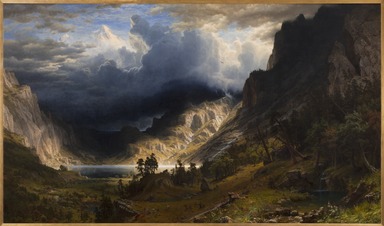Browse

| Accession # | 76.79 |
|---|---|
| Artist | Albert Bierstadt |
| Title | A Storm in the Rocky Mountains, Mt. Rosalie |
| Date | 1866 |
| Medium | Oil on canvas |
| Dimensions | frame: 98 5/8 × 158 1/8 × 7 1/4 in., 335 lb. (250.5 × 401.6 × 18.4 cm, 151.96kg) 83 × 142 1/4 in. (210.8 × 361.3 cm) |
| Signed | Signed lower right: "ABierstadt / N.Y. 1866" |
| Credit Line | Dick S. Ramsay Fund, Healy Purchase Fund B, Frank L. Babbott Fund, A. Augustus Healy Fund, Ella C. Woodward Memorial Fund, Carll H. de Silver Fund, Charles Stewart Smith Memorial Fund, Caroline A.L. Pratt Fund, Frederick Loeser Fund, Augustus Graham School of Design Fund, Museum Collection Fund, Special Subscription, and John B. Woodward Memorial Fund; Purchased with funds given by Daniel M. Kelly and Charles Simon; Bequest of Mrs. William T. Brewster, Gift of Mrs. W. Woodward Phelps in memory of her mother and father, Ella M. and John C. Southwick, Gift of Seymour Barnard, Bequest of Laura L. Barnes, Gift of J.A.H. Bell, and Bequest of Mark Finley, by exchange |
| Location | American Identities: Colony to Nation / Inventing American Landscape |
Curatorial Remarks: About this Brooklyn Icon
The Brooklyn Museum is commemorating its 200th anniversary by spotlighting 200 standout objects in its encyclopedic collection.
Albert Bierstadt’s monumental painting of stormy skies over a mountain peak has long captured viewers’ imaginations. The artist was famous for his depictions of the American West based on his own travels with scientific expeditions; this is considered one of his masterworks. It was created as a “Great Picture,” a term describing the 1800s trend in which enterprising artists painted huge canvases with dramatic scenes and then sold tickets to see them exhibited with theatrical lighting.
The painting’s sublime beauty conceals a legacy of colonialism and violence. In 1863, Bierstadt became the first European American to summit this peak and took it upon himself to name it Mount Rosalie, after his future wife. This act, along with his romanticized representation of the landscape and minutely rendered Indigenous population, perpetuated the idea of the American West as untouched wilderness available for the taking. In 1895, the mountain was renamed for John Evans, a former governor of Colorado Territory. Evans’s imperialist attitude toward the resident Arapaho and Cheyenne tribes had fueled military aggressions, resulting in the devastating Sand Creek Massacre in 1864. In 2023, after years of negotiations and Indigenous activism, the mountain was officially renamed Blue Sky with the consultation of local Arapaho and Cheyenne representatives.